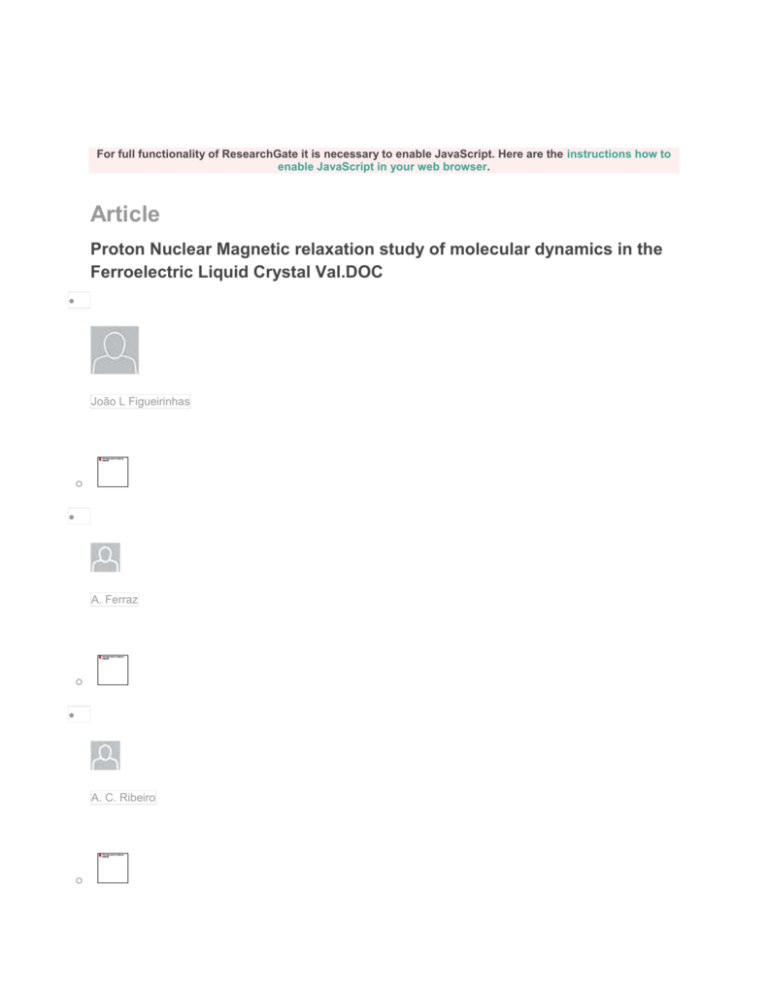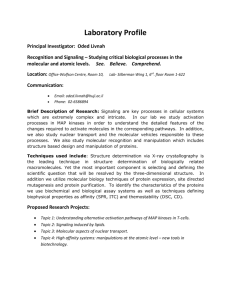
For full functionality of ResearchGate it is necessary to enable JavaScript. Here are the instructions how to
enable JavaScript in your web browser.
Article
Proton Nuclear Magnetic relaxation study of molecular dynamics in the
Ferroelectric Liquid Crystal Val.DOC
João L Figueirinhas
o
A. Ferraz
o
A. C. Ribeiro
o
H. T. Nguyen
o
F. Noack
o
Ferroelectrics (Impact Factor: 0.47). 09/1993; 146(1):123-135. DOI: 10.1080/00150199308008533
ABSTRACT
Molecular dynamics studies were carried out in the SA and SC mesophases of the Ferroelectric Liquid Crystal
Val.DOC by means of longitudinal proton spin relaxation dispersion. Fast field-cycling and conventional Nuclear
Magnetic Resonance (NMR) techniques were used to obtain the frequency dependence of T1 covering frequencies
from 10 to 3 × 10 Hz at two different temperatures in each mesophase. The T dispersion in both mesophases could
be well modeled by the proposed dominant relaxation mechanisms, namely collective motions, molecular self
diffusion and local molecular rotations. A Soft mode contribution to the spin-lattice relaxation could not be singled out
from the contribution of other collective motions. The diffusion constant D⊥perpendicular to the director was obtained
at all temperatures studied and involves an activation energy of about 35 kJ/mol. Effective correlation times
characterizing the average molecular rotations around the long axis and fluctuations of this axis, respectively, were
evaluated; their temperature dependence agrees with an Arrhenius type law with activation energies of about 50
kJ/mol.
0 FOLLOWERS
·
2 READS
REFERENCES
CITED IN (2)
Article: Molecular order in bilayer, anticlinic and ferroelectric smectic C mesophases
A. Carvalho · P.J. Sebastião · A. Ferraz · A.C. Ribeiro · H.T. Nguyen
[Show abstract] [Hide abstract]
ABSTRACT: In this work we present a proton NMR comparative study of the molecular order in the smectic C2 (),
smectic C^* () and anticlinic smectic C phases ( and ) of two liquid crystalline compounds. The second moments of
the experimental proton NMR spectra are well explained taking into account two different molecular orientations
models. From the analysis of our experimental results it was possible to estimate the tilt angles for all the smectic C
phases studied in this work.
No preview · Article · Jul 2000 · The European Physical Journal E
Request full-text
Article: Contribution of Proton NMR Relaxation to the Investigation of Molecular Dynamics and Molecular
Organisation in Liquid Crystalline Phases
AC Ribeiro · P. J. Sebastião · C. Cruz
[Show abstract] [Hide abstract]
ABSTRACT: We present in this paper some general remarks concerning proton Nuclear Magnetic Resonance
studies carried out in particular phases of calamitic, polycatenar and discotic molecules and we show how these
studies can be used to understand the molecular dynamics in different types of mesophases. We also illustrate how
these studies can contribute, in some cases, to test the validity of molecular organisation models proposed in the
literature to describe particular structures detected by X-ray diffraction.
No preview · Article · Jun 2001 · Molecular Crystals and Liquid Crystals
Request full-text
SIMILAR PUBLICATIONS
Functional second harmonic generation microscopy probes molecular dynamics with high temporal
resolution
Moritz Förderer, Tihomir Georgiev, Matias Mosqueira, Rainer H. A. Fink, Martin Vogel
Ionomer Self-Assembly in Dilute Solution Studied by Coarse-Grained Molecular Dynamics
Mahdi Ghelichi, Kourosh Malek, Michael H. Eikerling
Gate Opening Effect for Carbon Dioxide in ZIF-8 by Molecular Dynamics – Confirmed, but at High CO2
Pressure
T. Chokbunpiam, S. Fritzsche, C. Chmelik, J. Caro, W. Janke, S. Hannongbua
Data provided are for informational purposes only. Although carefully collected, accuracy cannot be guaranteed. The impact
factor represents a rough estimation of the journal's impact factor and does not reflect the actual current impact factor.
Publisher conditions are provided by RoMEO. Differing provisions from the publisher's actual policy or licence agreement
may be applicable.
© 2008‐2016 researchgate.net. All rights reserved. About us · Contact
us · Careers · Developers · News · Privacy · Terms | Advertising · Recruiting
Join for free
Log in
Email
Password Forgot password?
Keep me logged in
Log in
or log in with
ResearchGate is the professional network for scientists and researchers.
Join for free









